Human Resource Management Report: Practices, Trends, and Implications
VerifiedAdded on 2021/06/17
|13
|2965
|111
Report
AI Summary
This report delves into the core concepts of Human Resource Management (HRM), exploring its nature, characteristics, and strategic importance within organizations. It examines various people management strategies, procedures, and tools used to enhance workforce performance and achieve organizational goals. The report analyzes the wider implications and contributions of HRM in practice, emphasizing the importance of employee job satisfaction, motivation, and well-being. Current patterns and trends in HRM are discussed, with a specific focus on the Mace Group Limited and its integrated management system. Furthermore, the report includes relevant survey data, using the example of Amazon, to identify key issues in HRM practices, such as employee retention and engagement. Overall, the report offers insights into effective HRM practices and their impact on organizational success.
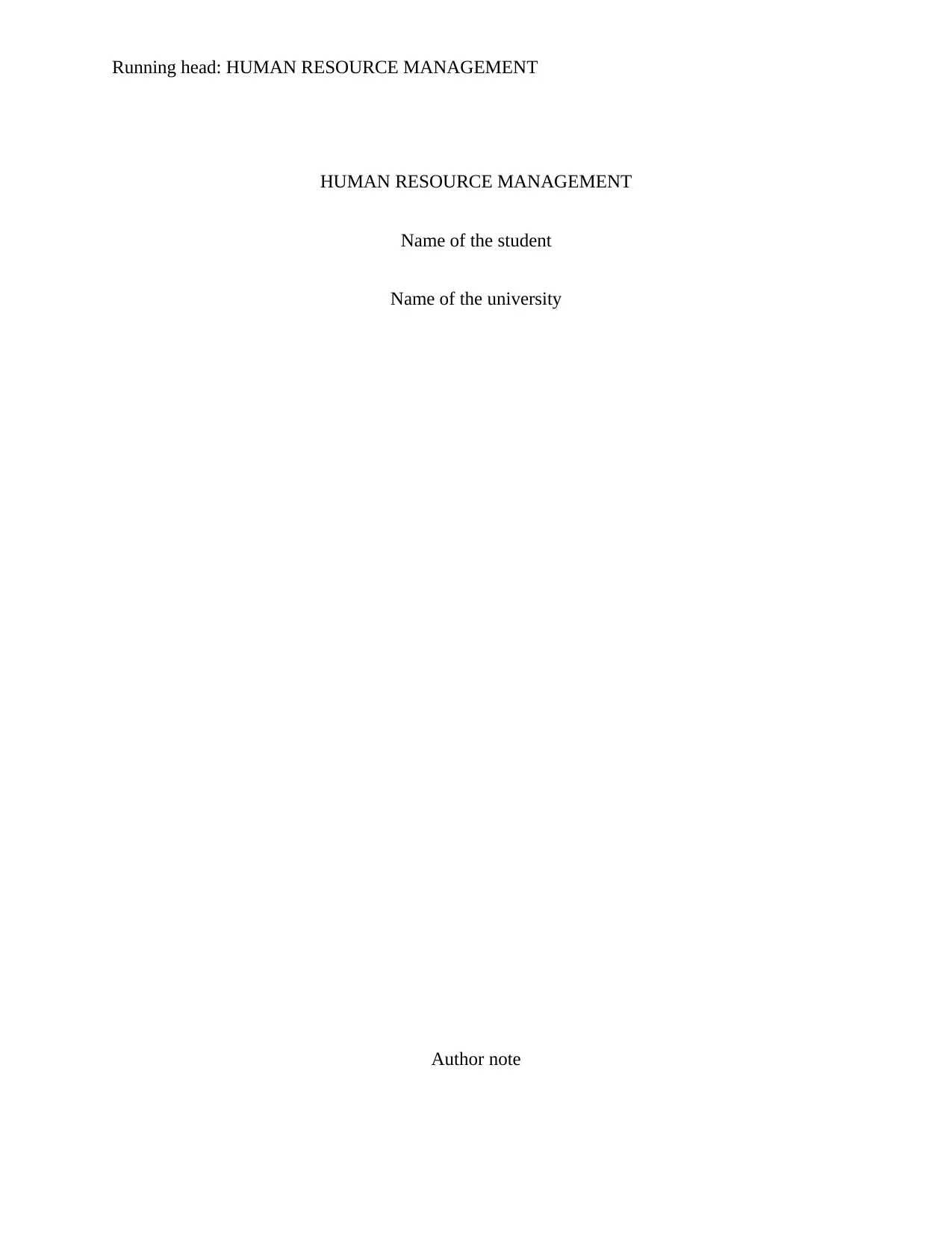
Running head: HUMAN RESOURCE MANAGEMENT
HUMAN RESOURCE MANAGEMENT
Name of the student
Name of the university
Author note
HUMAN RESOURCE MANAGEMENT
Name of the student
Name of the university
Author note
Paraphrase This Document
Need a fresh take? Get an instant paraphrase of this document with our AI Paraphraser
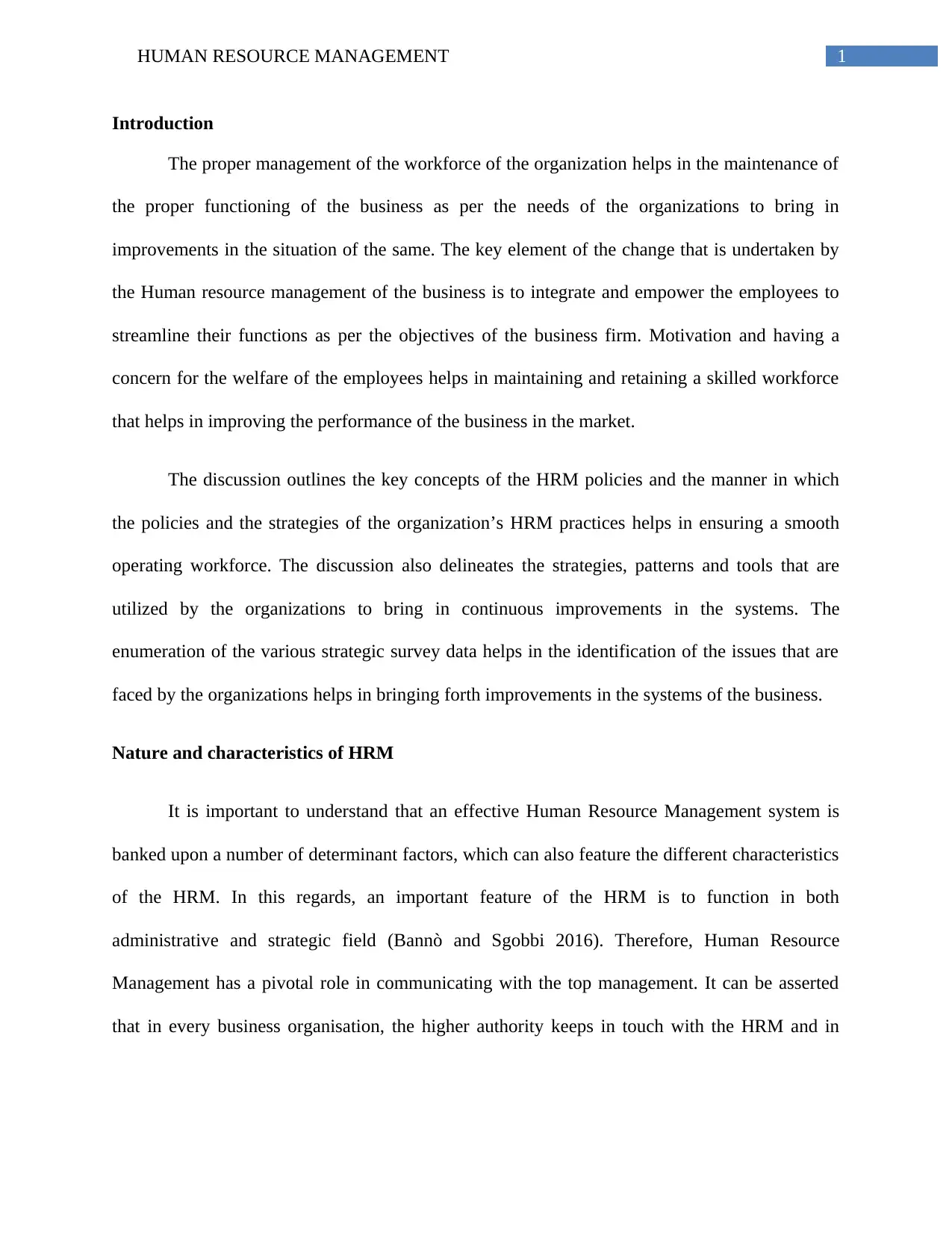
1HUMAN RESOURCE MANAGEMENT
Introduction
The proper management of the workforce of the organization helps in the maintenance of
the proper functioning of the business as per the needs of the organizations to bring in
improvements in the situation of the same. The key element of the change that is undertaken by
the Human resource management of the business is to integrate and empower the employees to
streamline their functions as per the objectives of the business firm. Motivation and having a
concern for the welfare of the employees helps in maintaining and retaining a skilled workforce
that helps in improving the performance of the business in the market.
The discussion outlines the key concepts of the HRM policies and the manner in which
the policies and the strategies of the organization’s HRM practices helps in ensuring a smooth
operating workforce. The discussion also delineates the strategies, patterns and tools that are
utilized by the organizations to bring in continuous improvements in the systems. The
enumeration of the various strategic survey data helps in the identification of the issues that are
faced by the organizations helps in bringing forth improvements in the systems of the business.
Nature and characteristics of HRM
It is important to understand that an effective Human Resource Management system is
banked upon a number of determinant factors, which can also feature the different characteristics
of the HRM. In this regards, an important feature of the HRM is to function in both
administrative and strategic field (Bannò and Sgobbi 2016). Therefore, Human Resource
Management has a pivotal role in communicating with the top management. It can be asserted
that in every business organisation, the higher authority keeps in touch with the HRM and in
Introduction
The proper management of the workforce of the organization helps in the maintenance of
the proper functioning of the business as per the needs of the organizations to bring in
improvements in the situation of the same. The key element of the change that is undertaken by
the Human resource management of the business is to integrate and empower the employees to
streamline their functions as per the objectives of the business firm. Motivation and having a
concern for the welfare of the employees helps in maintaining and retaining a skilled workforce
that helps in improving the performance of the business in the market.
The discussion outlines the key concepts of the HRM policies and the manner in which
the policies and the strategies of the organization’s HRM practices helps in ensuring a smooth
operating workforce. The discussion also delineates the strategies, patterns and tools that are
utilized by the organizations to bring in continuous improvements in the systems. The
enumeration of the various strategic survey data helps in the identification of the issues that are
faced by the organizations helps in bringing forth improvements in the systems of the business.
Nature and characteristics of HRM
It is important to understand that an effective Human Resource Management system is
banked upon a number of determinant factors, which can also feature the different characteristics
of the HRM. In this regards, an important feature of the HRM is to function in both
administrative and strategic field (Bannò and Sgobbi 2016). Therefore, Human Resource
Management has a pivotal role in communicating with the top management. It can be asserted
that in every business organisation, the higher authority keeps in touch with the HRM and in
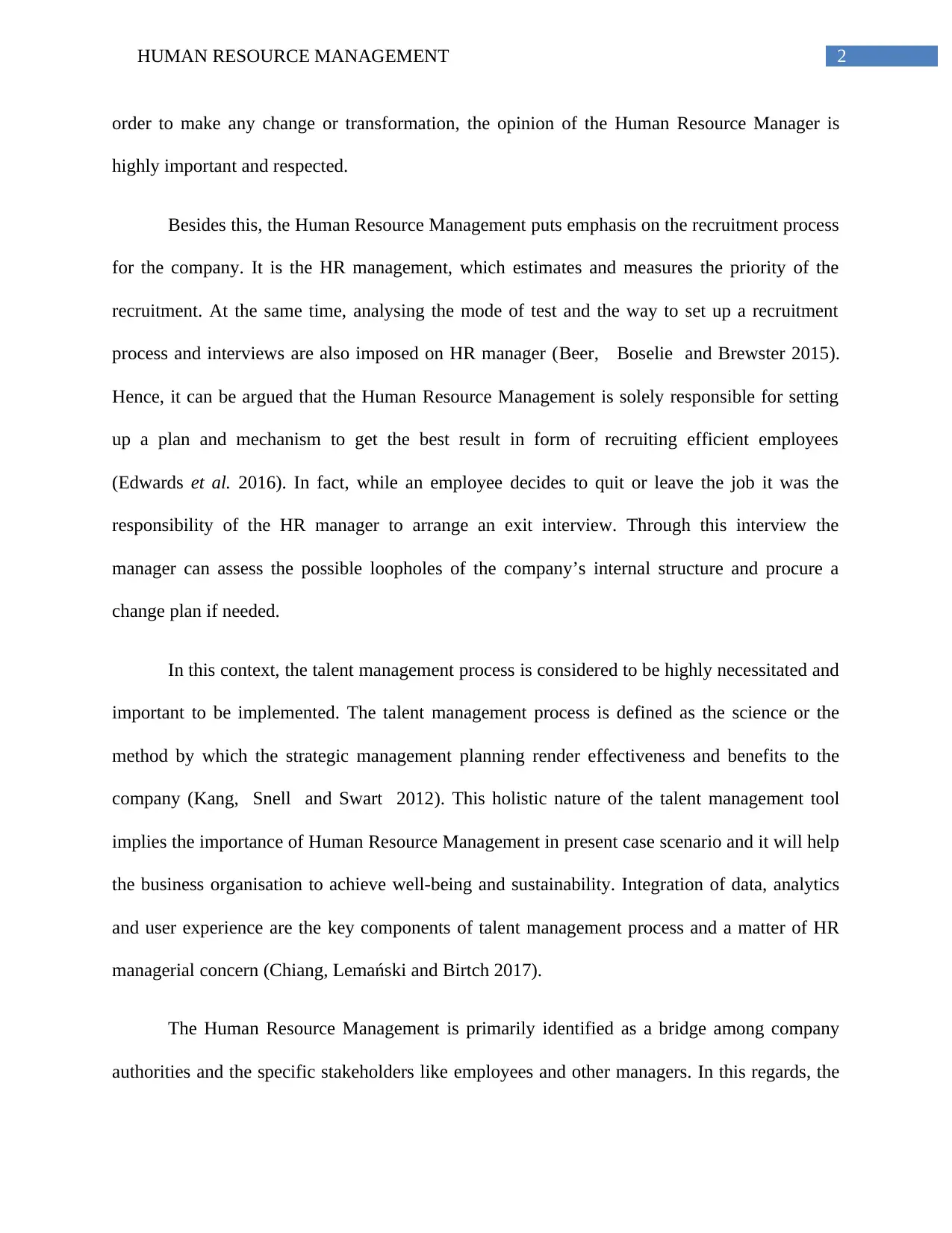
2HUMAN RESOURCE MANAGEMENT
order to make any change or transformation, the opinion of the Human Resource Manager is
highly important and respected.
Besides this, the Human Resource Management puts emphasis on the recruitment process
for the company. It is the HR management, which estimates and measures the priority of the
recruitment. At the same time, analysing the mode of test and the way to set up a recruitment
process and interviews are also imposed on HR manager (Beer, Boselie and Brewster 2015).
Hence, it can be argued that the Human Resource Management is solely responsible for setting
up a plan and mechanism to get the best result in form of recruiting efficient employees
(Edwards et al. 2016). In fact, while an employee decides to quit or leave the job it was the
responsibility of the HR manager to arrange an exit interview. Through this interview the
manager can assess the possible loopholes of the company’s internal structure and procure a
change plan if needed.
In this context, the talent management process is considered to be highly necessitated and
important to be implemented. The talent management process is defined as the science or the
method by which the strategic management planning render effectiveness and benefits to the
company (Kang, Snell and Swart 2012). This holistic nature of the talent management tool
implies the importance of Human Resource Management in present case scenario and it will help
the business organisation to achieve well-being and sustainability. Integration of data, analytics
and user experience are the key components of talent management process and a matter of HR
managerial concern (Chiang, Lemański and Birtch 2017).
The Human Resource Management is primarily identified as a bridge among company
authorities and the specific stakeholders like employees and other managers. In this regards, the
order to make any change or transformation, the opinion of the Human Resource Manager is
highly important and respected.
Besides this, the Human Resource Management puts emphasis on the recruitment process
for the company. It is the HR management, which estimates and measures the priority of the
recruitment. At the same time, analysing the mode of test and the way to set up a recruitment
process and interviews are also imposed on HR manager (Beer, Boselie and Brewster 2015).
Hence, it can be argued that the Human Resource Management is solely responsible for setting
up a plan and mechanism to get the best result in form of recruiting efficient employees
(Edwards et al. 2016). In fact, while an employee decides to quit or leave the job it was the
responsibility of the HR manager to arrange an exit interview. Through this interview the
manager can assess the possible loopholes of the company’s internal structure and procure a
change plan if needed.
In this context, the talent management process is considered to be highly necessitated and
important to be implemented. The talent management process is defined as the science or the
method by which the strategic management planning render effectiveness and benefits to the
company (Kang, Snell and Swart 2012). This holistic nature of the talent management tool
implies the importance of Human Resource Management in present case scenario and it will help
the business organisation to achieve well-being and sustainability. Integration of data, analytics
and user experience are the key components of talent management process and a matter of HR
managerial concern (Chiang, Lemański and Birtch 2017).
The Human Resource Management is primarily identified as a bridge among company
authorities and the specific stakeholders like employees and other managers. In this regards, the
⊘ This is a preview!⊘
Do you want full access?
Subscribe today to unlock all pages.

Trusted by 1+ million students worldwide
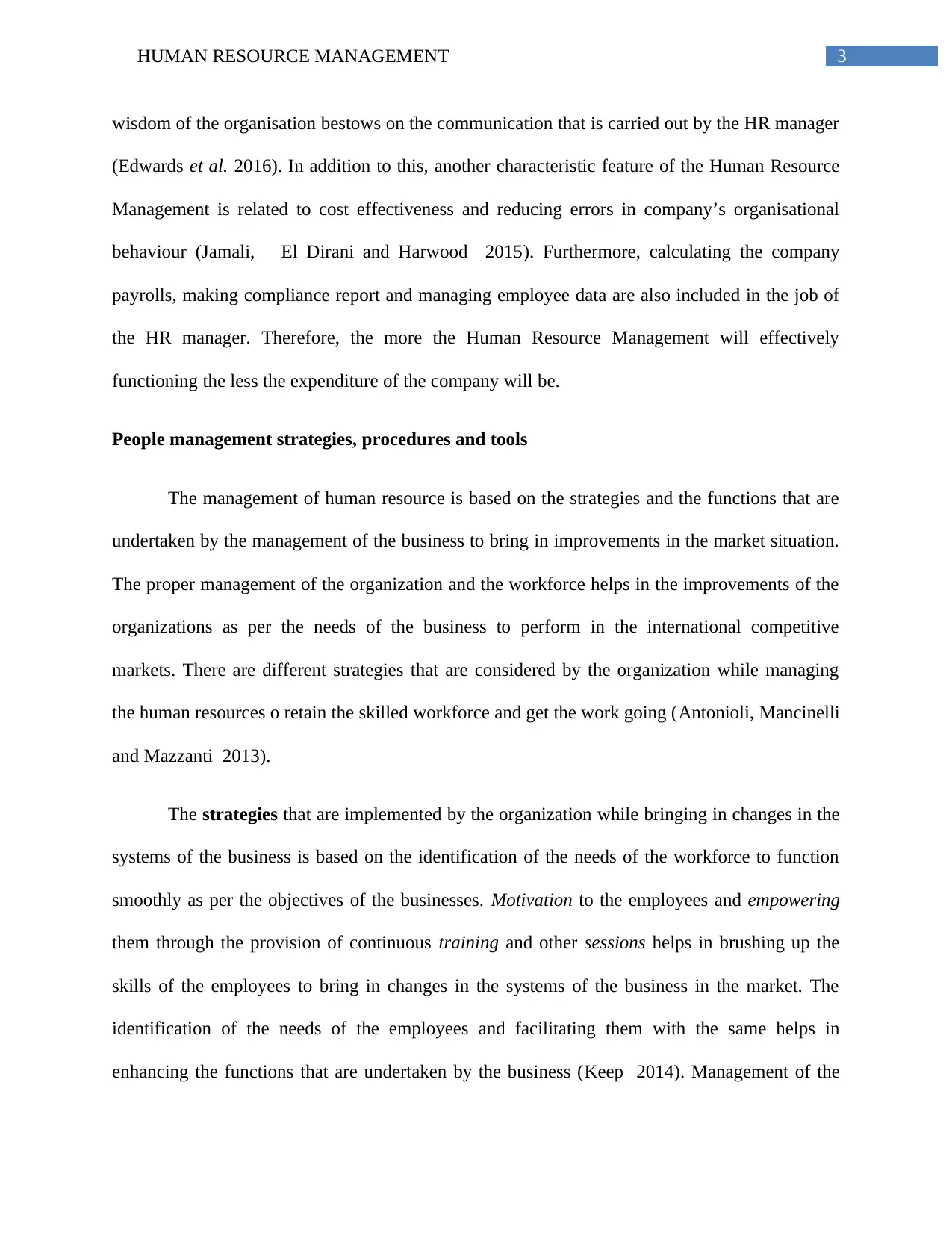
3HUMAN RESOURCE MANAGEMENT
wisdom of the organisation bestows on the communication that is carried out by the HR manager
(Edwards et al. 2016). In addition to this, another characteristic feature of the Human Resource
Management is related to cost effectiveness and reducing errors in company’s organisational
behaviour (Jamali, El Dirani and Harwood 2015). Furthermore, calculating the company
payrolls, making compliance report and managing employee data are also included in the job of
the HR manager. Therefore, the more the Human Resource Management will effectively
functioning the less the expenditure of the company will be.
People management strategies, procedures and tools
The management of human resource is based on the strategies and the functions that are
undertaken by the management of the business to bring in improvements in the market situation.
The proper management of the organization and the workforce helps in the improvements of the
organizations as per the needs of the business to perform in the international competitive
markets. There are different strategies that are considered by the organization while managing
the human resources o retain the skilled workforce and get the work going (Antonioli, Mancinelli
and Mazzanti 2013).
The strategies that are implemented by the organization while bringing in changes in the
systems of the business is based on the identification of the needs of the workforce to function
smoothly as per the objectives of the businesses. Motivation to the employees and empowering
them through the provision of continuous training and other sessions helps in brushing up the
skills of the employees to bring in changes in the systems of the business in the market. The
identification of the needs of the employees and facilitating them with the same helps in
enhancing the functions that are undertaken by the business (Keep 2014). Management of the
wisdom of the organisation bestows on the communication that is carried out by the HR manager
(Edwards et al. 2016). In addition to this, another characteristic feature of the Human Resource
Management is related to cost effectiveness and reducing errors in company’s organisational
behaviour (Jamali, El Dirani and Harwood 2015). Furthermore, calculating the company
payrolls, making compliance report and managing employee data are also included in the job of
the HR manager. Therefore, the more the Human Resource Management will effectively
functioning the less the expenditure of the company will be.
People management strategies, procedures and tools
The management of human resource is based on the strategies and the functions that are
undertaken by the management of the business to bring in improvements in the market situation.
The proper management of the organization and the workforce helps in the improvements of the
organizations as per the needs of the business to perform in the international competitive
markets. There are different strategies that are considered by the organization while managing
the human resources o retain the skilled workforce and get the work going (Antonioli, Mancinelli
and Mazzanti 2013).
The strategies that are implemented by the organization while bringing in changes in the
systems of the business is based on the identification of the needs of the workforce to function
smoothly as per the objectives of the businesses. Motivation to the employees and empowering
them through the provision of continuous training and other sessions helps in brushing up the
skills of the employees to bring in changes in the systems of the business in the market. The
identification of the needs of the employees and facilitating them with the same helps in
enhancing the functions that are undertaken by the business (Keep 2014). Management of the
Paraphrase This Document
Need a fresh take? Get an instant paraphrase of this document with our AI Paraphraser
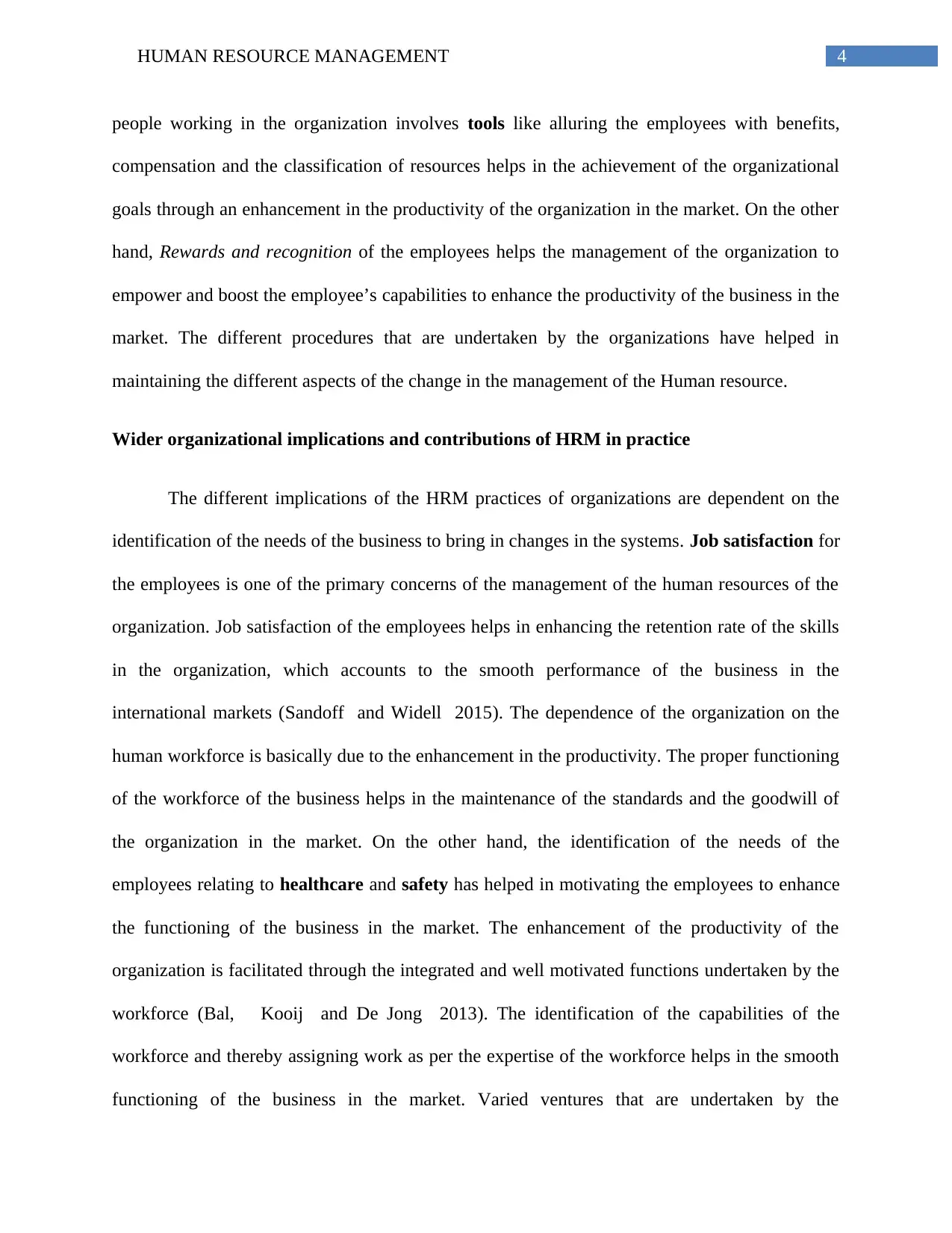
4HUMAN RESOURCE MANAGEMENT
people working in the organization involves tools like alluring the employees with benefits,
compensation and the classification of resources helps in the achievement of the organizational
goals through an enhancement in the productivity of the organization in the market. On the other
hand, Rewards and recognition of the employees helps the management of the organization to
empower and boost the employee’s capabilities to enhance the productivity of the business in the
market. The different procedures that are undertaken by the organizations have helped in
maintaining the different aspects of the change in the management of the Human resource.
Wider organizational implications and contributions of HRM in practice
The different implications of the HRM practices of organizations are dependent on the
identification of the needs of the business to bring in changes in the systems. Job satisfaction for
the employees is one of the primary concerns of the management of the human resources of the
organization. Job satisfaction of the employees helps in enhancing the retention rate of the skills
in the organization, which accounts to the smooth performance of the business in the
international markets (Sandoff and Widell 2015). The dependence of the organization on the
human workforce is basically due to the enhancement in the productivity. The proper functioning
of the workforce of the business helps in the maintenance of the standards and the goodwill of
the organization in the market. On the other hand, the identification of the needs of the
employees relating to healthcare and safety has helped in motivating the employees to enhance
the functioning of the business in the market. The enhancement of the productivity of the
organization is facilitated through the integrated and well motivated functions undertaken by the
workforce (Bal, Kooij and De Jong 2013). The identification of the capabilities of the
workforce and thereby assigning work as per the expertise of the workforce helps in the smooth
functioning of the business in the market. Varied ventures that are undertaken by the
people working in the organization involves tools like alluring the employees with benefits,
compensation and the classification of resources helps in the achievement of the organizational
goals through an enhancement in the productivity of the organization in the market. On the other
hand, Rewards and recognition of the employees helps the management of the organization to
empower and boost the employee’s capabilities to enhance the productivity of the business in the
market. The different procedures that are undertaken by the organizations have helped in
maintaining the different aspects of the change in the management of the Human resource.
Wider organizational implications and contributions of HRM in practice
The different implications of the HRM practices of organizations are dependent on the
identification of the needs of the business to bring in changes in the systems. Job satisfaction for
the employees is one of the primary concerns of the management of the human resources of the
organization. Job satisfaction of the employees helps in enhancing the retention rate of the skills
in the organization, which accounts to the smooth performance of the business in the
international markets (Sandoff and Widell 2015). The dependence of the organization on the
human workforce is basically due to the enhancement in the productivity. The proper functioning
of the workforce of the business helps in the maintenance of the standards and the goodwill of
the organization in the market. On the other hand, the identification of the needs of the
employees relating to healthcare and safety has helped in motivating the employees to enhance
the functioning of the business in the market. The enhancement of the productivity of the
organization is facilitated through the integrated and well motivated functions undertaken by the
workforce (Bal, Kooij and De Jong 2013). The identification of the capabilities of the
workforce and thereby assigning work as per the expertise of the workforce helps in the smooth
functioning of the business in the market. Varied ventures that are undertaken by the
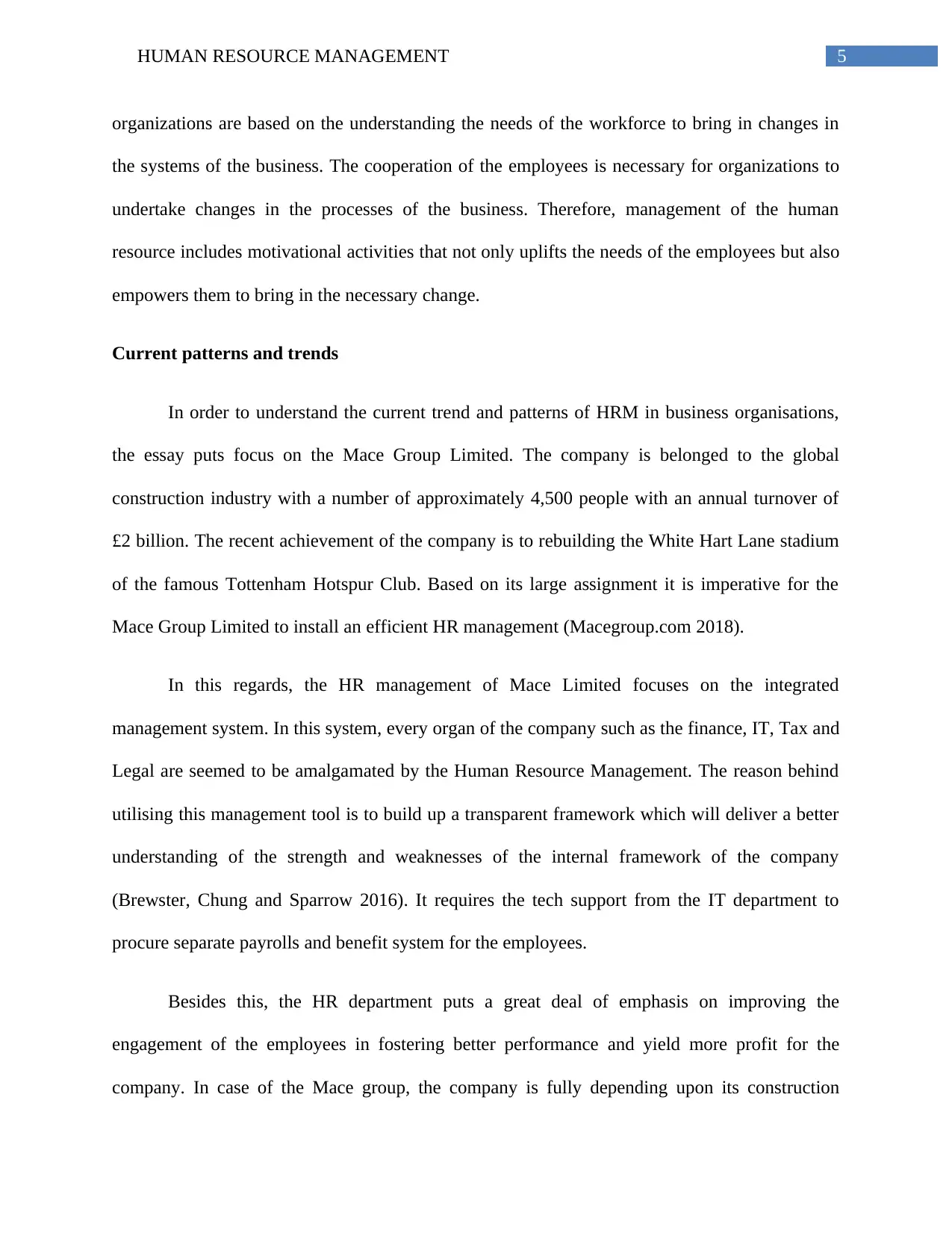
5HUMAN RESOURCE MANAGEMENT
organizations are based on the understanding the needs of the workforce to bring in changes in
the systems of the business. The cooperation of the employees is necessary for organizations to
undertake changes in the processes of the business. Therefore, management of the human
resource includes motivational activities that not only uplifts the needs of the employees but also
empowers them to bring in the necessary change.
Current patterns and trends
In order to understand the current trend and patterns of HRM in business organisations,
the essay puts focus on the Mace Group Limited. The company is belonged to the global
construction industry with a number of approximately 4,500 people with an annual turnover of
£2 billion. The recent achievement of the company is to rebuilding the White Hart Lane stadium
of the famous Tottenham Hotspur Club. Based on its large assignment it is imperative for the
Mace Group Limited to install an efficient HR management (Macegroup.com 2018).
In this regards, the HR management of Mace Limited focuses on the integrated
management system. In this system, every organ of the company such as the finance, IT, Tax and
Legal are seemed to be amalgamated by the Human Resource Management. The reason behind
utilising this management tool is to build up a transparent framework which will deliver a better
understanding of the strength and weaknesses of the internal framework of the company
(Brewster, Chung and Sparrow 2016). It requires the tech support from the IT department to
procure separate payrolls and benefit system for the employees.
Besides this, the HR department puts a great deal of emphasis on improving the
engagement of the employees in fostering better performance and yield more profit for the
company. In case of the Mace group, the company is fully depending upon its construction
organizations are based on the understanding the needs of the workforce to bring in changes in
the systems of the business. The cooperation of the employees is necessary for organizations to
undertake changes in the processes of the business. Therefore, management of the human
resource includes motivational activities that not only uplifts the needs of the employees but also
empowers them to bring in the necessary change.
Current patterns and trends
In order to understand the current trend and patterns of HRM in business organisations,
the essay puts focus on the Mace Group Limited. The company is belonged to the global
construction industry with a number of approximately 4,500 people with an annual turnover of
£2 billion. The recent achievement of the company is to rebuilding the White Hart Lane stadium
of the famous Tottenham Hotspur Club. Based on its large assignment it is imperative for the
Mace Group Limited to install an efficient HR management (Macegroup.com 2018).
In this regards, the HR management of Mace Limited focuses on the integrated
management system. In this system, every organ of the company such as the finance, IT, Tax and
Legal are seemed to be amalgamated by the Human Resource Management. The reason behind
utilising this management tool is to build up a transparent framework which will deliver a better
understanding of the strength and weaknesses of the internal framework of the company
(Brewster, Chung and Sparrow 2016). It requires the tech support from the IT department to
procure separate payrolls and benefit system for the employees.
Besides this, the HR department puts a great deal of emphasis on improving the
engagement of the employees in fostering better performance and yield more profit for the
company. In case of the Mace group, the company is fully depending upon its construction
⊘ This is a preview!⊘
Do you want full access?
Subscribe today to unlock all pages.

Trusted by 1+ million students worldwide
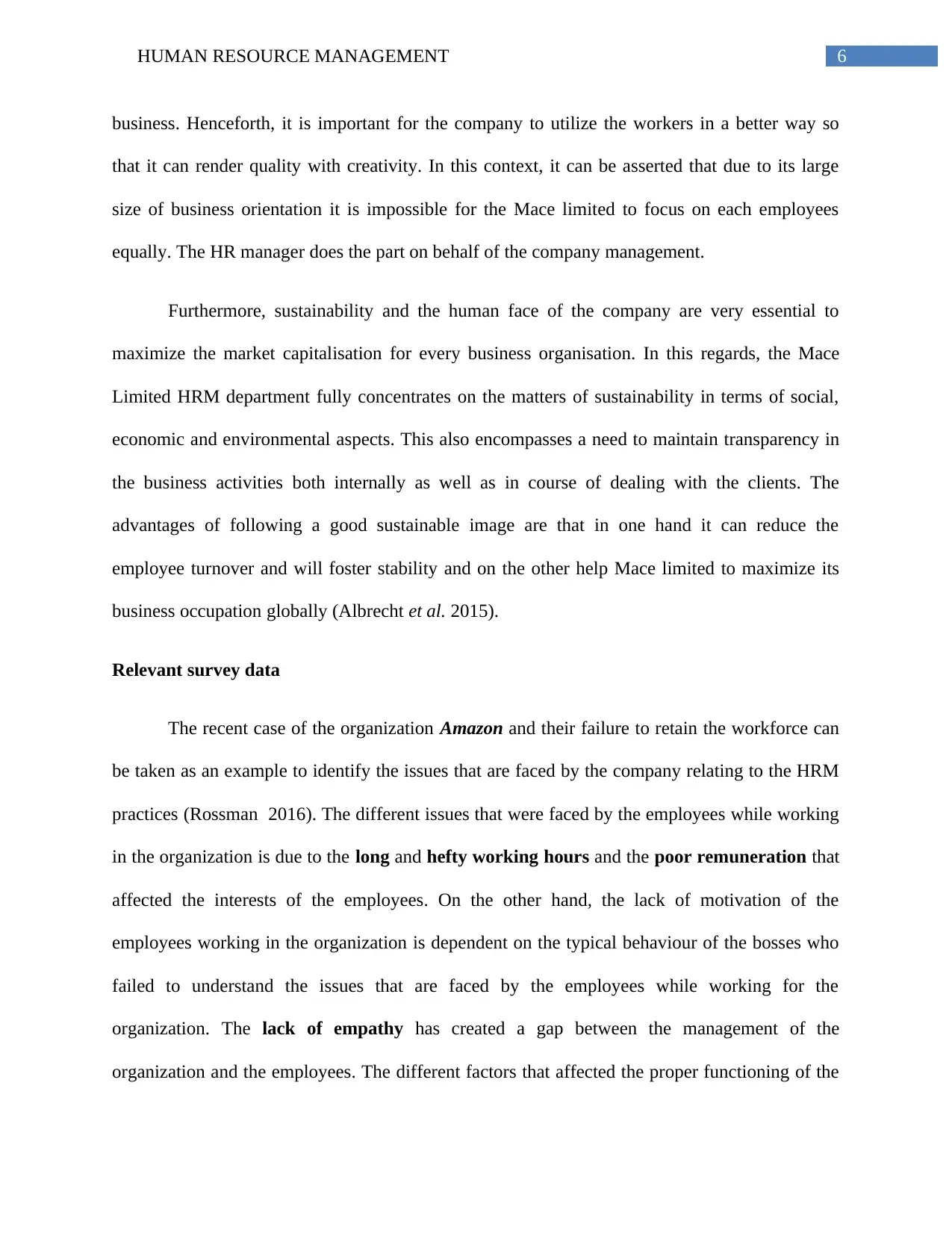
6HUMAN RESOURCE MANAGEMENT
business. Henceforth, it is important for the company to utilize the workers in a better way so
that it can render quality with creativity. In this context, it can be asserted that due to its large
size of business orientation it is impossible for the Mace limited to focus on each employees
equally. The HR manager does the part on behalf of the company management.
Furthermore, sustainability and the human face of the company are very essential to
maximize the market capitalisation for every business organisation. In this regards, the Mace
Limited HRM department fully concentrates on the matters of sustainability in terms of social,
economic and environmental aspects. This also encompasses a need to maintain transparency in
the business activities both internally as well as in course of dealing with the clients. The
advantages of following a good sustainable image are that in one hand it can reduce the
employee turnover and will foster stability and on the other help Mace limited to maximize its
business occupation globally (Albrecht et al. 2015).
Relevant survey data
The recent case of the organization Amazon and their failure to retain the workforce can
be taken as an example to identify the issues that are faced by the company relating to the HRM
practices (Rossman 2016). The different issues that were faced by the employees while working
in the organization is due to the long and hefty working hours and the poor remuneration that
affected the interests of the employees. On the other hand, the lack of motivation of the
employees working in the organization is dependent on the typical behaviour of the bosses who
failed to understand the issues that are faced by the employees while working for the
organization. The lack of empathy has created a gap between the management of the
organization and the employees. The different factors that affected the proper functioning of the
business. Henceforth, it is important for the company to utilize the workers in a better way so
that it can render quality with creativity. In this context, it can be asserted that due to its large
size of business orientation it is impossible for the Mace limited to focus on each employees
equally. The HR manager does the part on behalf of the company management.
Furthermore, sustainability and the human face of the company are very essential to
maximize the market capitalisation for every business organisation. In this regards, the Mace
Limited HRM department fully concentrates on the matters of sustainability in terms of social,
economic and environmental aspects. This also encompasses a need to maintain transparency in
the business activities both internally as well as in course of dealing with the clients. The
advantages of following a good sustainable image are that in one hand it can reduce the
employee turnover and will foster stability and on the other help Mace limited to maximize its
business occupation globally (Albrecht et al. 2015).
Relevant survey data
The recent case of the organization Amazon and their failure to retain the workforce can
be taken as an example to identify the issues that are faced by the company relating to the HRM
practices (Rossman 2016). The different issues that were faced by the employees while working
in the organization is due to the long and hefty working hours and the poor remuneration that
affected the interests of the employees. On the other hand, the lack of motivation of the
employees working in the organization is dependent on the typical behaviour of the bosses who
failed to understand the issues that are faced by the employees while working for the
organization. The lack of empathy has created a gap between the management of the
organization and the employees. The different factors that affected the proper functioning of the
Paraphrase This Document
Need a fresh take? Get an instant paraphrase of this document with our AI Paraphraser
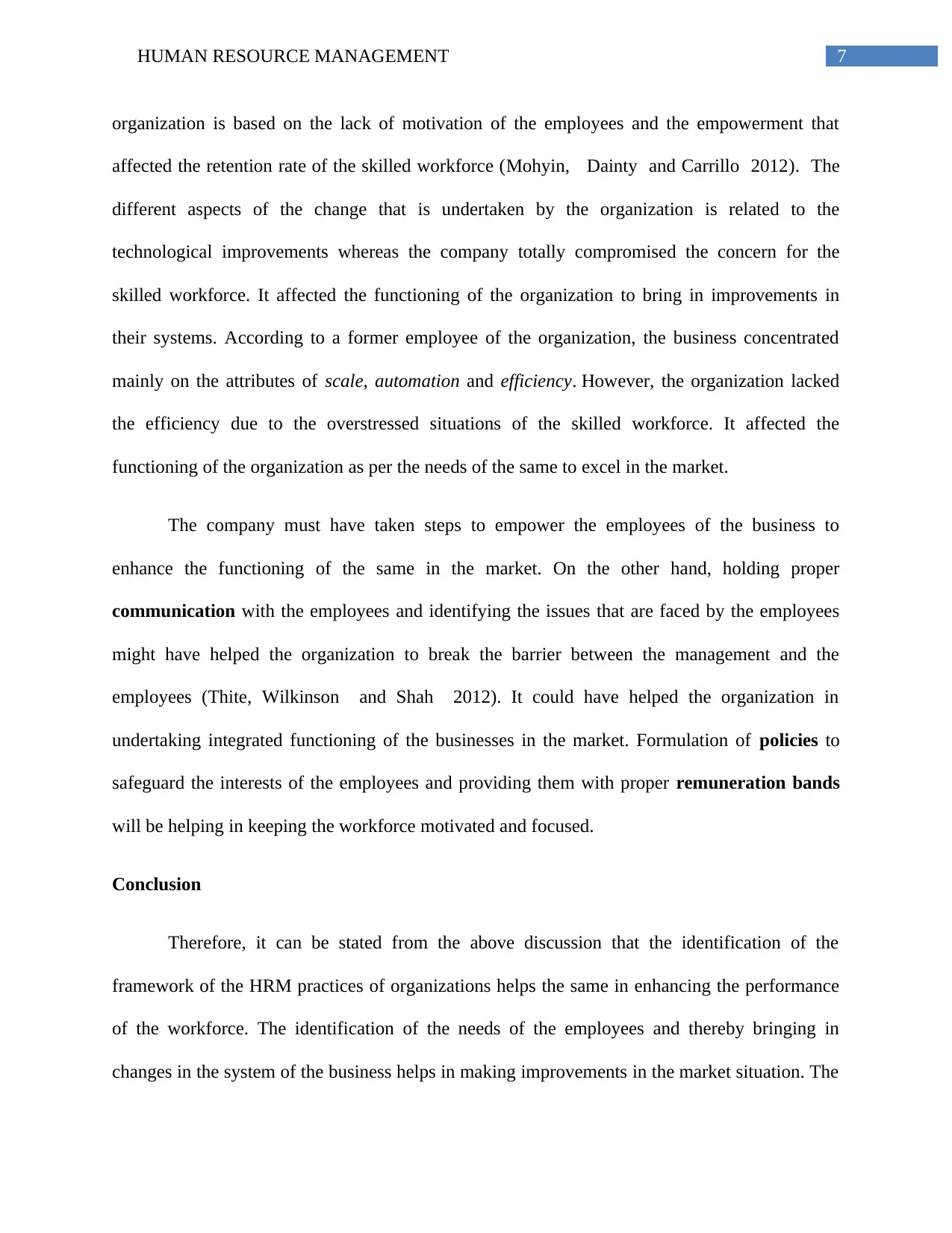
7HUMAN RESOURCE MANAGEMENT
organization is based on the lack of motivation of the employees and the empowerment that
affected the retention rate of the skilled workforce (Mohyin, Dainty and Carrillo 2012). The
different aspects of the change that is undertaken by the organization is related to the
technological improvements whereas the company totally compromised the concern for the
skilled workforce. It affected the functioning of the organization to bring in improvements in
their systems. According to a former employee of the organization, the business concentrated
mainly on the attributes of scale, automation and efficiency. However, the organization lacked
the efficiency due to the overstressed situations of the skilled workforce. It affected the
functioning of the organization as per the needs of the same to excel in the market.
The company must have taken steps to empower the employees of the business to
enhance the functioning of the same in the market. On the other hand, holding proper
communication with the employees and identifying the issues that are faced by the employees
might have helped the organization to break the barrier between the management and the
employees (Thite, Wilkinson and Shah 2012). It could have helped the organization in
undertaking integrated functioning of the businesses in the market. Formulation of policies to
safeguard the interests of the employees and providing them with proper remuneration bands
will be helping in keeping the workforce motivated and focused.
Conclusion
Therefore, it can be stated from the above discussion that the identification of the
framework of the HRM practices of organizations helps the same in enhancing the performance
of the workforce. The identification of the needs of the employees and thereby bringing in
changes in the system of the business helps in making improvements in the market situation. The
organization is based on the lack of motivation of the employees and the empowerment that
affected the retention rate of the skilled workforce (Mohyin, Dainty and Carrillo 2012). The
different aspects of the change that is undertaken by the organization is related to the
technological improvements whereas the company totally compromised the concern for the
skilled workforce. It affected the functioning of the organization to bring in improvements in
their systems. According to a former employee of the organization, the business concentrated
mainly on the attributes of scale, automation and efficiency. However, the organization lacked
the efficiency due to the overstressed situations of the skilled workforce. It affected the
functioning of the organization as per the needs of the same to excel in the market.
The company must have taken steps to empower the employees of the business to
enhance the functioning of the same in the market. On the other hand, holding proper
communication with the employees and identifying the issues that are faced by the employees
might have helped the organization to break the barrier between the management and the
employees (Thite, Wilkinson and Shah 2012). It could have helped the organization in
undertaking integrated functioning of the businesses in the market. Formulation of policies to
safeguard the interests of the employees and providing them with proper remuneration bands
will be helping in keeping the workforce motivated and focused.
Conclusion
Therefore, it can be stated from the above discussion that the identification of the
framework of the HRM practices of organizations helps the same in enhancing the performance
of the workforce. The identification of the needs of the employees and thereby bringing in
changes in the system of the business helps in making improvements in the market situation. The
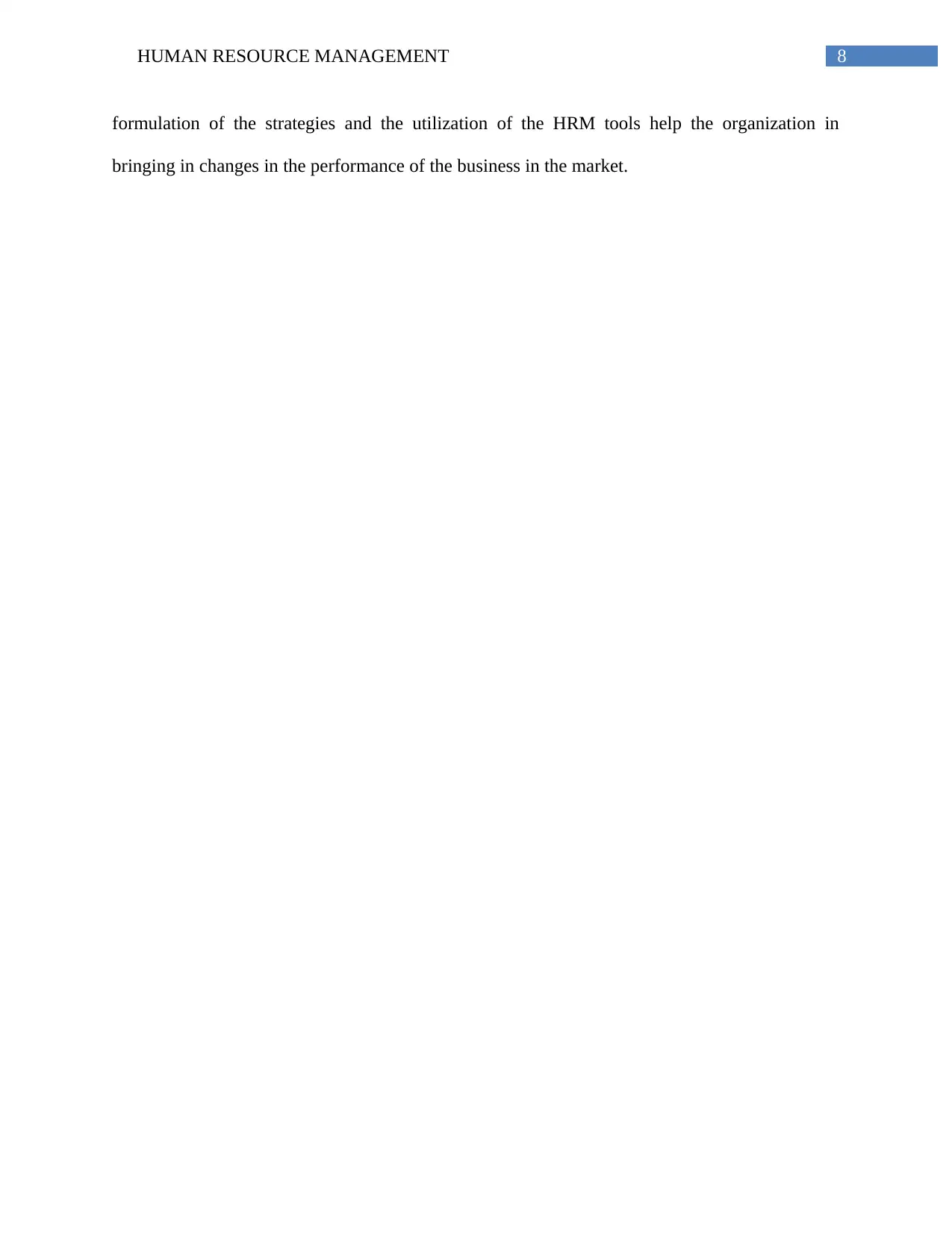
8HUMAN RESOURCE MANAGEMENT
formulation of the strategies and the utilization of the HRM tools help the organization in
bringing in changes in the performance of the business in the market.
formulation of the strategies and the utilization of the HRM tools help the organization in
bringing in changes in the performance of the business in the market.
⊘ This is a preview!⊘
Do you want full access?
Subscribe today to unlock all pages.

Trusted by 1+ million students worldwide
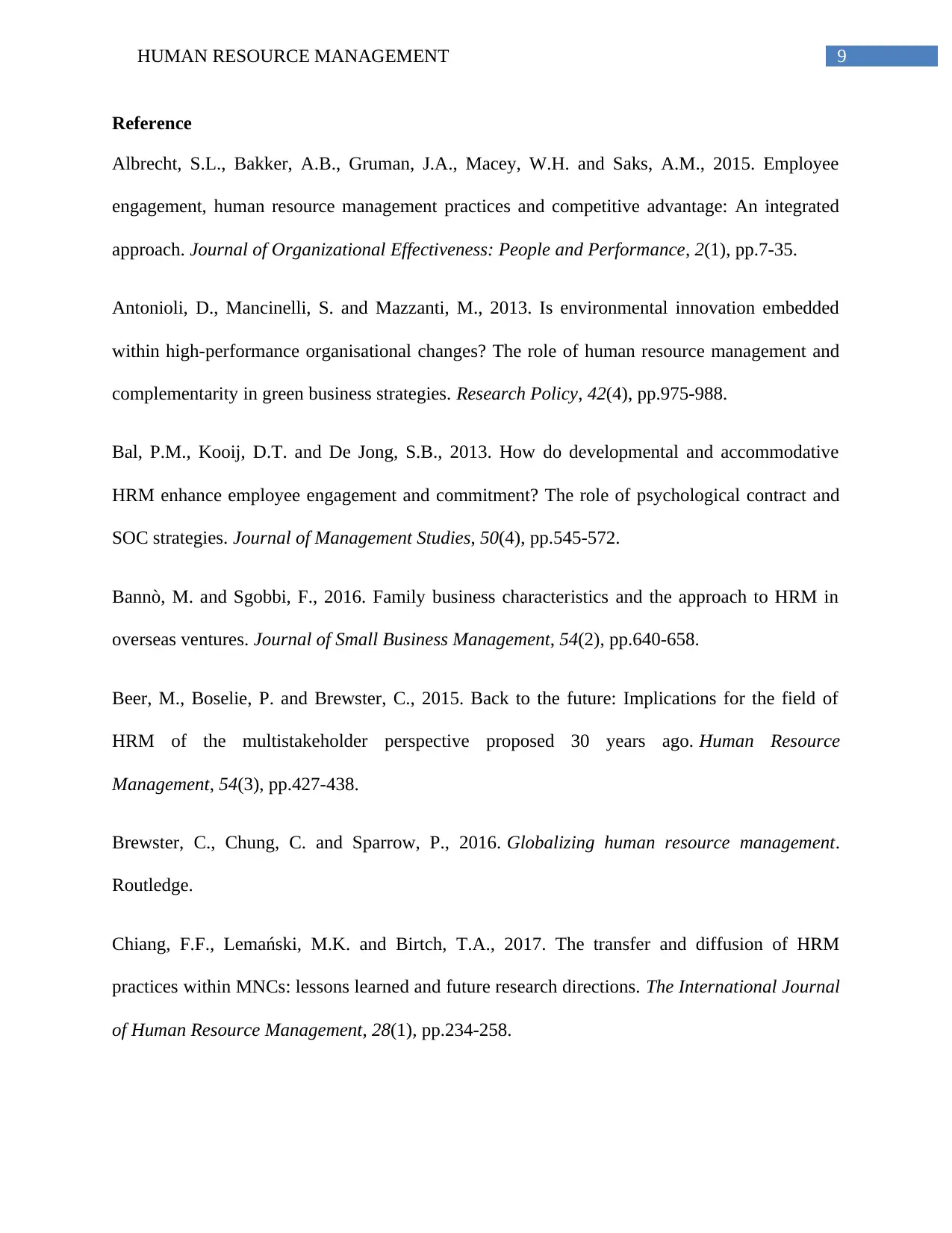
9HUMAN RESOURCE MANAGEMENT
Reference
Albrecht, S.L., Bakker, A.B., Gruman, J.A., Macey, W.H. and Saks, A.M., 2015. Employee
engagement, human resource management practices and competitive advantage: An integrated
approach. Journal of Organizational Effectiveness: People and Performance, 2(1), pp.7-35.
Antonioli, D., Mancinelli, S. and Mazzanti, M., 2013. Is environmental innovation embedded
within high-performance organisational changes? The role of human resource management and
complementarity in green business strategies. Research Policy, 42(4), pp.975-988.
Bal, P.M., Kooij, D.T. and De Jong, S.B., 2013. How do developmental and accommodative
HRM enhance employee engagement and commitment? The role of psychological contract and
SOC strategies. Journal of Management Studies, 50(4), pp.545-572.
Bannò, M. and Sgobbi, F., 2016. Family business characteristics and the approach to HRM in
overseas ventures. Journal of Small Business Management, 54(2), pp.640-658.
Beer, M., Boselie, P. and Brewster, C., 2015. Back to the future: Implications for the field of
HRM of the multistakeholder perspective proposed 30 years ago. Human Resource
Management, 54(3), pp.427-438.
Brewster, C., Chung, C. and Sparrow, P., 2016. Globalizing human resource management.
Routledge.
Chiang, F.F., Lemański, M.K. and Birtch, T.A., 2017. The transfer and diffusion of HRM
practices within MNCs: lessons learned and future research directions. The International Journal
of Human Resource Management, 28(1), pp.234-258.
Reference
Albrecht, S.L., Bakker, A.B., Gruman, J.A., Macey, W.H. and Saks, A.M., 2015. Employee
engagement, human resource management practices and competitive advantage: An integrated
approach. Journal of Organizational Effectiveness: People and Performance, 2(1), pp.7-35.
Antonioli, D., Mancinelli, S. and Mazzanti, M., 2013. Is environmental innovation embedded
within high-performance organisational changes? The role of human resource management and
complementarity in green business strategies. Research Policy, 42(4), pp.975-988.
Bal, P.M., Kooij, D.T. and De Jong, S.B., 2013. How do developmental and accommodative
HRM enhance employee engagement and commitment? The role of psychological contract and
SOC strategies. Journal of Management Studies, 50(4), pp.545-572.
Bannò, M. and Sgobbi, F., 2016. Family business characteristics and the approach to HRM in
overseas ventures. Journal of Small Business Management, 54(2), pp.640-658.
Beer, M., Boselie, P. and Brewster, C., 2015. Back to the future: Implications for the field of
HRM of the multistakeholder perspective proposed 30 years ago. Human Resource
Management, 54(3), pp.427-438.
Brewster, C., Chung, C. and Sparrow, P., 2016. Globalizing human resource management.
Routledge.
Chiang, F.F., Lemański, M.K. and Birtch, T.A., 2017. The transfer and diffusion of HRM
practices within MNCs: lessons learned and future research directions. The International Journal
of Human Resource Management, 28(1), pp.234-258.
Paraphrase This Document
Need a fresh take? Get an instant paraphrase of this document with our AI Paraphraser
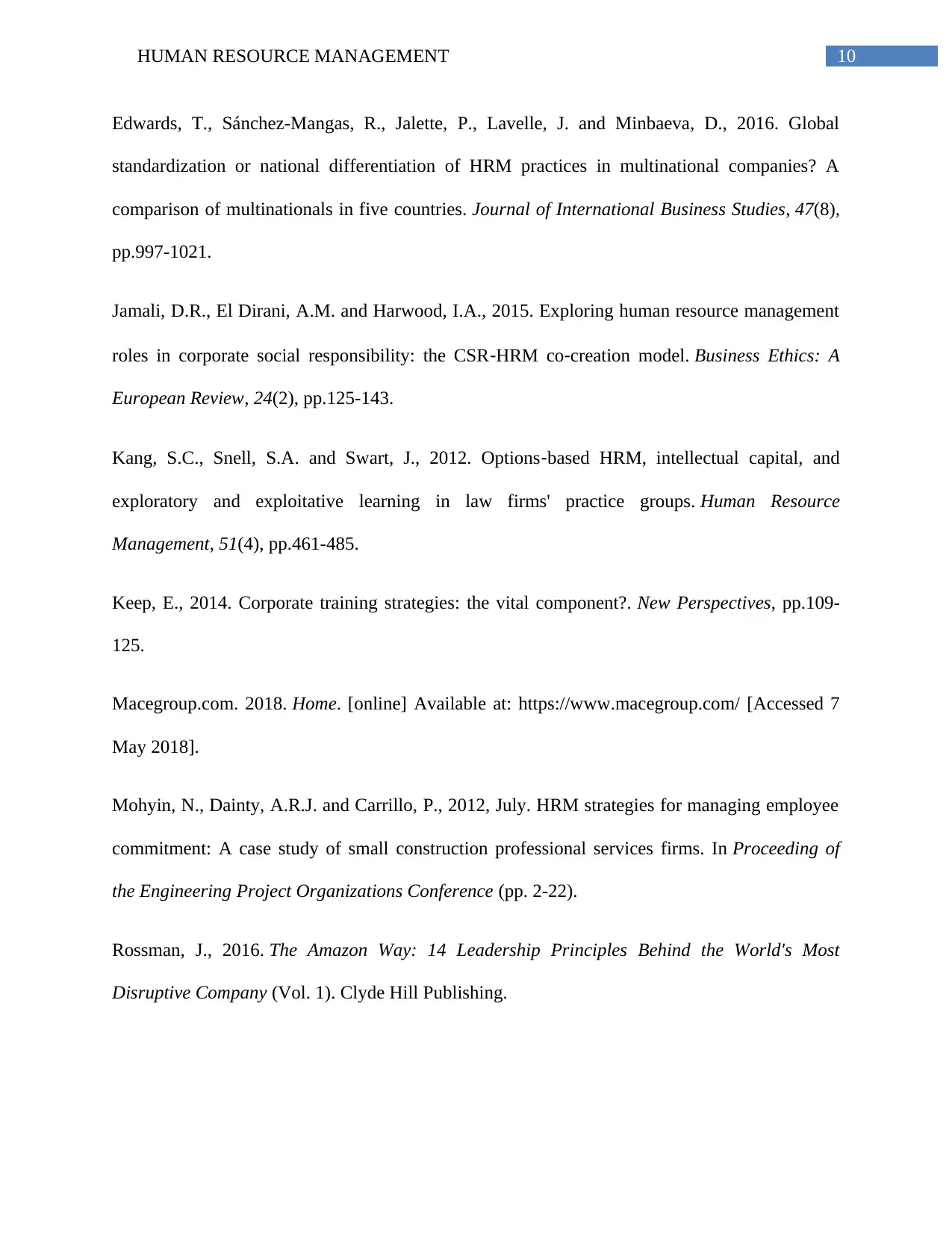
10HUMAN RESOURCE MANAGEMENT
Edwards, T., Sánchez-Mangas, R., Jalette, P., Lavelle, J. and Minbaeva, D., 2016. Global
standardization or national differentiation of HRM practices in multinational companies? A
comparison of multinationals in five countries. Journal of International Business Studies, 47(8),
pp.997-1021.
Jamali, D.R., El Dirani, A.M. and Harwood, I.A., 2015. Exploring human resource management
roles in corporate social responsibility: the CSR‐HRM co‐creation model. Business Ethics: A
European Review, 24(2), pp.125-143.
Kang, S.C., Snell, S.A. and Swart, J., 2012. Options‐based HRM, intellectual capital, and
exploratory and exploitative learning in law firms' practice groups. Human Resource
Management, 51(4), pp.461-485.
Keep, E., 2014. Corporate training strategies: the vital component?. New Perspectives, pp.109-
125.
Macegroup.com. 2018. Home. [online] Available at: https://www.macegroup.com/ [Accessed 7
May 2018].
Mohyin, N., Dainty, A.R.J. and Carrillo, P., 2012, July. HRM strategies for managing employee
commitment: A case study of small construction professional services firms. In Proceeding of
the Engineering Project Organizations Conference (pp. 2-22).
Rossman, J., 2016. The Amazon Way: 14 Leadership Principles Behind the World's Most
Disruptive Company (Vol. 1). Clyde Hill Publishing.
Edwards, T., Sánchez-Mangas, R., Jalette, P., Lavelle, J. and Minbaeva, D., 2016. Global
standardization or national differentiation of HRM practices in multinational companies? A
comparison of multinationals in five countries. Journal of International Business Studies, 47(8),
pp.997-1021.
Jamali, D.R., El Dirani, A.M. and Harwood, I.A., 2015. Exploring human resource management
roles in corporate social responsibility: the CSR‐HRM co‐creation model. Business Ethics: A
European Review, 24(2), pp.125-143.
Kang, S.C., Snell, S.A. and Swart, J., 2012. Options‐based HRM, intellectual capital, and
exploratory and exploitative learning in law firms' practice groups. Human Resource
Management, 51(4), pp.461-485.
Keep, E., 2014. Corporate training strategies: the vital component?. New Perspectives, pp.109-
125.
Macegroup.com. 2018. Home. [online] Available at: https://www.macegroup.com/ [Accessed 7
May 2018].
Mohyin, N., Dainty, A.R.J. and Carrillo, P., 2012, July. HRM strategies for managing employee
commitment: A case study of small construction professional services firms. In Proceeding of
the Engineering Project Organizations Conference (pp. 2-22).
Rossman, J., 2016. The Amazon Way: 14 Leadership Principles Behind the World's Most
Disruptive Company (Vol. 1). Clyde Hill Publishing.
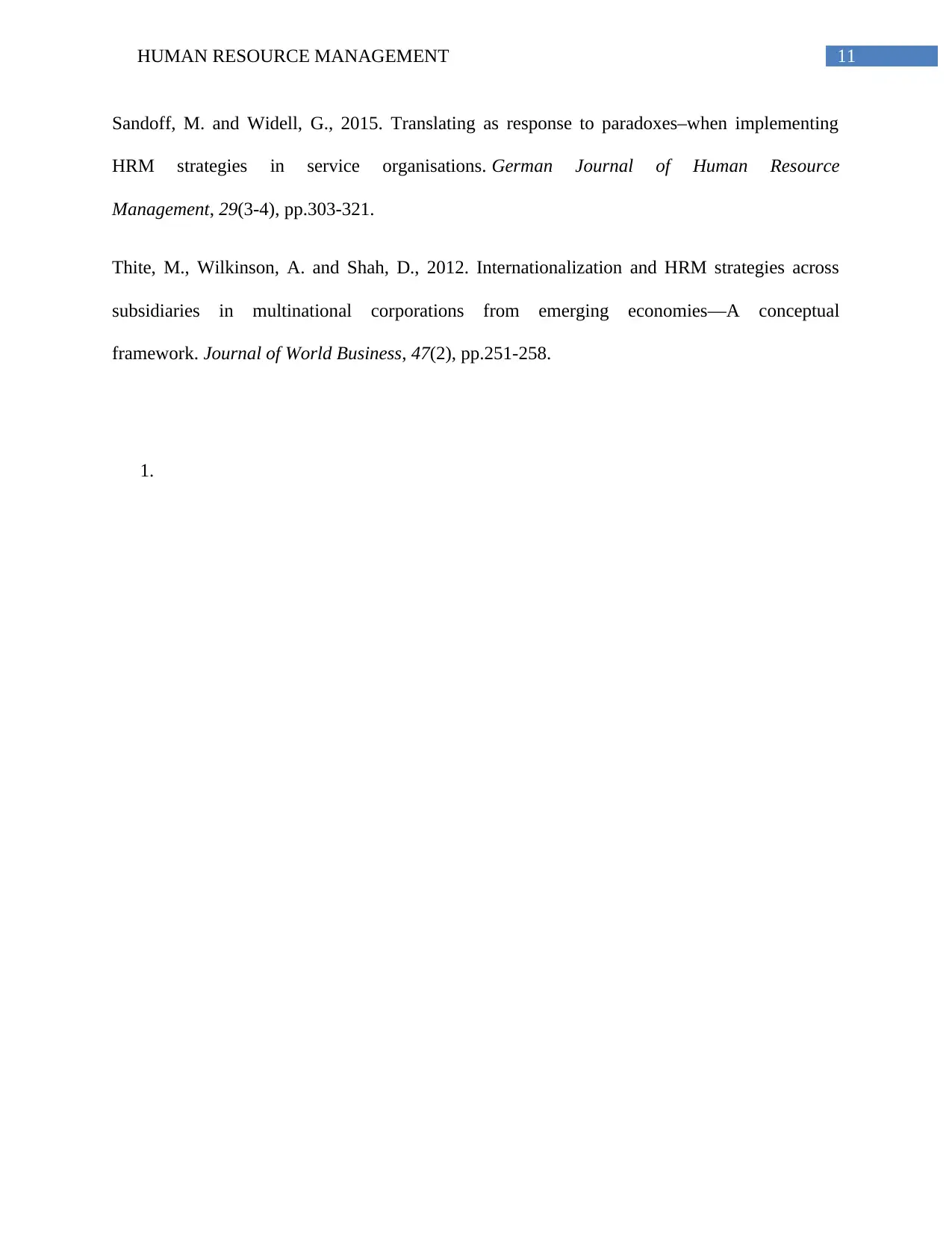
11HUMAN RESOURCE MANAGEMENT
Sandoff, M. and Widell, G., 2015. Translating as response to paradoxes–when implementing
HRM strategies in service organisations. German Journal of Human Resource
Management, 29(3-4), pp.303-321.
Thite, M., Wilkinson, A. and Shah, D., 2012. Internationalization and HRM strategies across
subsidiaries in multinational corporations from emerging economies—A conceptual
framework. Journal of World Business, 47(2), pp.251-258.
1.
Sandoff, M. and Widell, G., 2015. Translating as response to paradoxes–when implementing
HRM strategies in service organisations. German Journal of Human Resource
Management, 29(3-4), pp.303-321.
Thite, M., Wilkinson, A. and Shah, D., 2012. Internationalization and HRM strategies across
subsidiaries in multinational corporations from emerging economies—A conceptual
framework. Journal of World Business, 47(2), pp.251-258.
1.
⊘ This is a preview!⊘
Do you want full access?
Subscribe today to unlock all pages.

Trusted by 1+ million students worldwide
1 out of 13
Related Documents
Your All-in-One AI-Powered Toolkit for Academic Success.
+13062052269
info@desklib.com
Available 24*7 on WhatsApp / Email
![[object Object]](/_next/static/media/star-bottom.7253800d.svg)
Unlock your academic potential
Copyright © 2020–2025 A2Z Services. All Rights Reserved. Developed and managed by ZUCOL.





